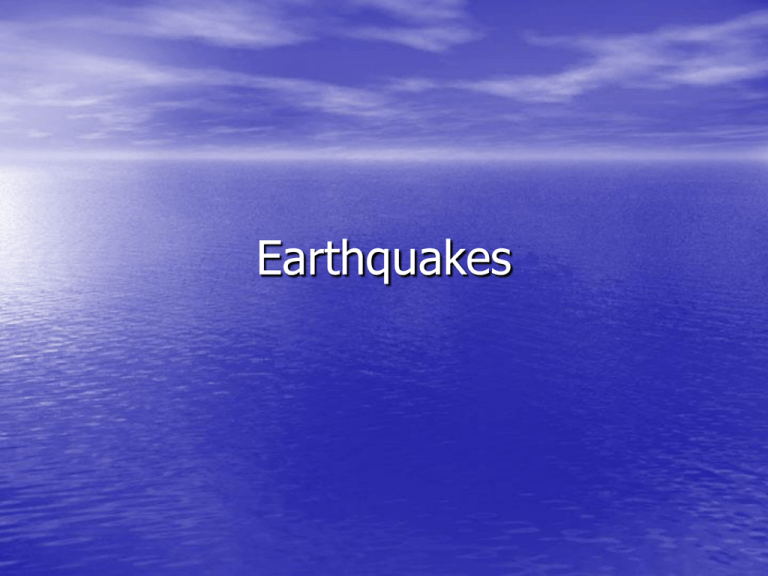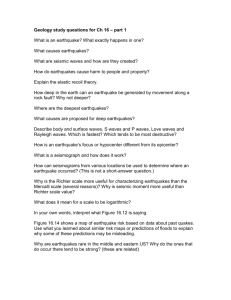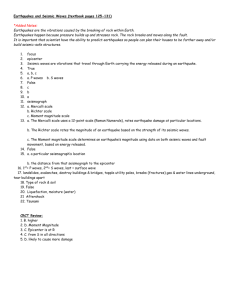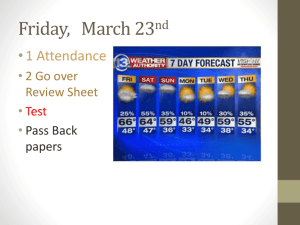Earthquakes - teamafrica
advertisement

Earthquakes Quick Write • Write everything you know about earthquakes in bullets. Play Earthquake video’s Fault: • A break in the rocks that make up the Earth’s crust, along which rocks on either side have moved past each other. • When the movement of rock on either side is sudden, the released energy causes an earthquake. Earthquake: • Movement of the ground, caused by waves from energy released as rocks move along faults. 3 Types of Faults • 1. Normal Fault: – Rocks are pulled apart. – Rocks undergo tension. Refer to usgs favorites site. • 2. Reverse Fault: – Compression forces push on rocks causing them to bend and break. – Rocks above fault surface are forced up. Refer to usgs favorites site. • Strike-Slip fault: – Result from shear forces. – Two plates are moving sideways past each other. Journal • Why is it important to learn about the different types of faults? Focus: • The point under the ground where earthquake energy is released. Seismic Waves: • Waves that move outward from the earthquake focus and make the ground shake. Epicenter: • The point that is on top of the ground. Directly above the focus. • This is the closest scientists can get to the focus. 3 Types of Seismic Waves • 1. Primary waves (P-waves): • Waves that move through Earth by causing particles in rocks to move back and forth. • Begin at focus and travels to epicenter. • Fastest waves. • It travels through solids, liquids, and gases.These waves slow down at outer core but, do not stop. They travel through solid inner core. • 2. Secondary Waves (S-waves): • Move through Earth by causing particles in rocks to move up and down. • Begin at focus and travels to epicenter. • These waves only travel through solids. Don’t move through liquids or gases. They stop completely when they hit liquid outer core. Surface waves (L-waves): • Begin at the epicenter and travel outward in a elliptical and side to side motion. • Travel outward from epicenter. • Slowest waves. Cause most of the destruction during an earthquake. Journal • Why is learning about the three types of waves (P, S, and L-waves) so important? Seismologist: • A scientist that studies earthquakes and seismic waves. Seismograph: • An instrument that detects earthquakes. It also, records primary, secondary, and surface waves. Seismograph Reading • Pgs. 246-247 Magnitude: • It’s the measurement of the size or (strength) amount of energy that was released during the earthquake. Richter Scale: • Measures energy released by the earthquake. • Standard scale used to compare earthquakes. • Scale ranges from 1-10. A 1.0 to 2.0 earthquake • is not noticeable. A 10.0 is the strongest. It is 32 times stronger than the preceding number. (Ex. 4.0 earthquake is about 32 times stronger than a 3.0 earthquake). Tsunami: • Huge waves that can cause great devastation and loss of life when they strike a coast. • Caused by an underwater earthquake. • caused by an underwater earthquake, • • • • • • • • How are earthquakes measured? A seismometer is an instrument that senses the earth's motion; a seismograph combines a seismometer with recording equipment to obtain a permanent record of the motion. From this record scientists can calculate how much energy was released in an earthquake, which is one way to decide its magnitude. Calculations are made from several different seismograms, both close to and far from an earthquake source to determine its magnitude. Calculations from various seismic stations and seismographs should give the same magnitude, with only one magnitude for any given earthquake. To determine the strength and location of earthquakes, scientists use a recording instrument known as a seismograph. A seismograph is equipped with sensors called seismometers that can detect ground motions caused by seismic waves from both near and distant earthquakes. Some seismometers are capable of detecting ground motion as small as 1 billionth of a meter, or about 40 billionth of an inch. A seismograph produces wavy lines that reflect the size of seismic waves passing beneath it. The record of the wave, called a seismogram, is imprinted on paper, film, or recording tape or is stored and displayed by computers The Richter scale is a standard scale used to compare earthquakes. It is a logarithmic scale, meaning that the numbers on the scale measure factors of 10. So, for example, an earthquake that measures 4.0 on the Richter scale is 10 times larger than one that measures 3.0. On the Richter scale, anything below 2.0 is undetectable to a normal person and is called a microquake. Microquakes occur constantly. Moderate earthquakes measure less than 6.0 or so on the Richter scale. Earthquakes measuring more than 6.0 can cause significant damage. The maximum quake rating ever measured is about 8.9. The Modified Mercalli Intensity Scale uses Roman Numerals from I to XII to describe different earthquake effects is commonly used. • • • • • • • • • • • • • How are earthquakes measured? A seismometer is an instrument that senses the earth's motion; a seismograph combines a seismometer with recording equipment to obtain a permanent record of the motion. From this record scientists can calculate how much energy was released in an earthquake, which is one way to decide its magnitude. Calculations are made from several different seismograms, both close to and far from an earthquake source to determine its magnitude. Calculations from various seismic stations and seismographs should give the same magnitude, with only one magnitude for any given earthquake. To determine the strength and location of earthquakes, scientists use a recording instrument known as a seismograph. A seismograph is equipped with sensors called seismometers that can detect ground motions caused by seismic waves from both near and distant earthquakes. Some seismometers are capable of detecting ground motion as small as 1 billionth of a meter, or about 40 billionth of an inch. A seismograph produces wavy lines that reflect the size of seismic waves passing beneath it. The record of the wave, called a seismogram, is imprinted on paper, film, or recording tape or is stored and displayed by computers The Richter scale is a standard scale used to compare earthquakes. It is a logarithmic scale, meaning that the numbers on the scale measure factors of 10. So, for example, an earthquake that measures 4.0 on the Richter scale is 10 times larger than one that measures 3.0. On the Richter scale, anything below 2.0 is undetectable to a normal person and is called a microquake. Microquakes occur constantly. Moderate earthquakes measure less than 6.0 or so on the Richter scale. Earthquakes measuring more than 6.0 can cause significant damage. The maximum quake rating ever measured is about 8.9. The Modified Mercalli Intensity Scale uses Roman Numerals from I to XII to describe different earthquake effects is commonly used. Back 7,000+ sites by kids for kids Privacy Policy Terms of Use








